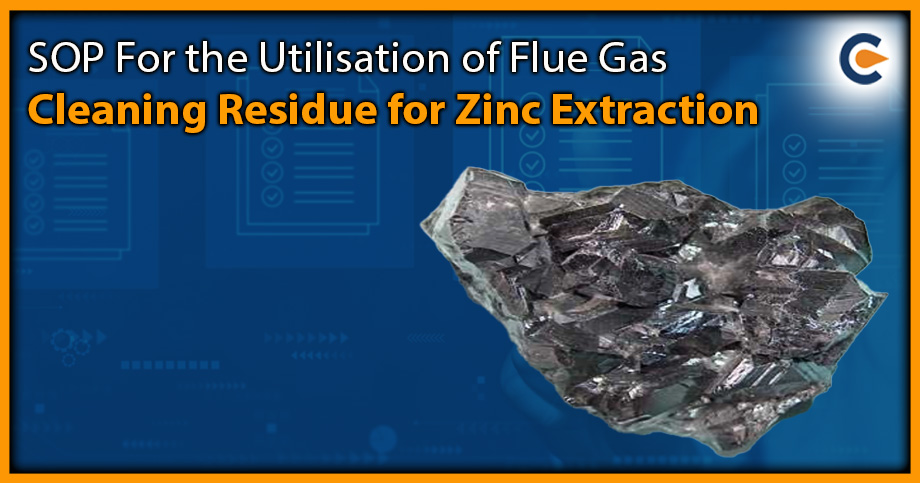The utilisation of Flue gas cleaning residue generated from steel scraps melting induction furnace for zinc extraction requires strict adherence to safety guidelines and procedures. The residue must have a minimum zinc content of 30% to be economically recoverable. It should be collected in a dry state using bags and stored in a designated covered area that is cool, dry, well-ventilated, and authorised by the concerned SPCB/PCC. The residue is ignited remotely and calcined in a closed chamber under negative pressure with an APCD followed by a stack. The dust collected in the bag filter can be reused in the process, and residue generated from filter press-I can be used in a captive induction furnace for metal recovery, while residue generated from filter press-II can only be sent to lead recycling units authorised for lead residue recycling under HOWM Rules, 2016.
Standard Operating Procedure for Utilisation of Flue gas cleaning residue for Zinc Extraction
This SOP for the Utilisation of Flue gas cleaning residue generated from steel scraps is applicable only for the utilization of Flue gas cleaning residue generated from Steel scrap melting plant using an induction furnace as a raw material for extraction of Zinc metal. The SoP for the utilisation are as follows:
- The Flue gas cleaning residue must have at least 30% zinc content to be economically recoverable.
- The Flue gas cleaning residue should be collected in a dry state using bags at the bottom of the hopper through a rotary airlock valve from the Bag filter connected to the steel scrap induction furnace.
- The sender or receiver must label, package, and transport hazardous waste, including the residue generated during utilisation, according to the authorisation issued by the concerned SPCB under the HOWM Rules, 2016. Necessary safeguards must be implemented to prevent waste pilferage.
- Igniting the flue gas cleaning residue remotely using a gas burner (only for ignition) and calcination of the residue should occur in a closed chamber under negative pressure, with an APCD like Bag filter followed by a stack of sufficient height as prescribed by the concerned SPCB/PCC.
- For the Utilisation of Flue gas cleaning residue, a mechanised conveyor system must be used to load the flue gas cleaning residue (with no manual handling) and transfer it to the leaching tank.
- Appropriate mechanised mixing systems should be used to mix the flue gas cleaning residue with chemicals and additives in the leaching tank and mix chemicals in the purification tank.
- The chemicals, additives, leachate, and filtrate of the utilization process should be transferred to the appropriate reaction/storage tanks through mechanised conveyor systems using chemical process pumps.
- The residue generated from filter Press-I can be used in a captive induction furnace to recover metals.
- Flue gas cleaning residue cannot be used during unstable/breakdown conditions in process units or any of the emission control systems of the waste utilisation process.
SOP for Installing Pollution Control Measure
- The scrubbed gases/vapours from the stack shall meet the emission norms and shall be dispersed into the atmosphere through a stack of height as prescribed by the concerned SPCB/PCC.
- The above wastewater shall be treated in ETP, and the management of treated effluent or its discharge shall be carried out in accordance with the conditions stipulated in the Consent to Operate issued by respective SPCB/PCC under the Water (Prevention and Control of Pollution) Act, 1974[1].
SOP For Storage
The unit must obtain authorisation from the concerned State Pollution Control Board under the HOWM Rules, 2016, for the generation (wherever applicable), storage, and utilisation of Flue gas cleaning residue prior to utilisation. The SOP for Storage are as follows.
- The flue gas cleaning residue should be stored in a designated covered storage area. To prevent water intrusion, the storage area should be cool, dry, well-ventilated, and covered, as authorised by the concerned SPCB/PCC under the HOWM Rules, 2016. The SOP are as follows
- Chemicals and additives must be purchased in non-reactive containers/drums and kept in a cool, dry, well-ventilated, and covered storage shed.
- The storage shed for chemicals and additives must have an impervious lined floor, adequate slope, and a seepage collection pit. The loading/unloading area for chemicals and additives must also be under the covered shed.
- The entire process area shall have leak-proof pipelines with adequate slopes to collect runoff/spillage, if any, into the collection pit. The spillages from the collection pit shall be transferred to ETP or leaching tank, as the case may be, through a chemical process pump.
- The unit must ensure proper ventilation in the work zone and process areas.
- The unit must provide suitable fire safety arrangements and flame-proof electrical fittings.
- The unit will take immediate corrective actions, conduct environmental site assessments, and remediate any environmental damage caused by improper handling of hazardous waste. This is in accordance with the “Guidelines on Implementing Liabilities for Environmental Damages due to Handling & Disposal of Hazardous Wastes and Penalty” published by CPCB.
- If the filter press residues are not recycled as specified, the unit must become a member of a common hazardous waste treatment, storage, and disposal facility.
SOP For Waste Disposal under Utilisation of Flue Gas Cleaning Residue
The unit must comply with the requirements of the Public Liability Insurance Act, 1991, as amended, during the utilisation and handling of hazardous waste, if applicable. The applicable SOP are as follow.
- The residue generated from filter press-II may only be sent to lead recycling units with rotary kilns for lead recovery. Such recycling units must have authorisation for recycling lead residue from the concerned SPCB/PCC under the HOWM Rules, 2016.
- The dust collected in the calcination chamber’s bag filter can be reused in the leaching tank.
- The filter residues generated from filter press-I and filter press-II must be disposed of in authorised TSDF if not recycled or recovered following the Hazardous and Other Wastes (Management and Transboundary Movement) Rules, 2016.
- The sources of wastewater from the utilisation process are bearing cooling water (pump sealing water), bleed water from the scrubber, and wastewater from floor washing/reactor wash/vehicle wash/spillages etc. Pump sealing water, scrubber bleed water, and reactor wash shall be reused in the leaching tank, wherever possible.
Record/Return Filing for the Utilization of Flue gas cleaning residue
The record return and filing required in the Utilisation of Flue gas cleaning residue generated from steel scraps are as follows:
- The unit must regularly provide information on the amount of flue gas cleaning residue produced and utilised and the conservation of resources to the relevant State Pollution Control Board (SPCB) quarterly and annually.
- The unit should keep a logbook containing details of the source, quantity, and date-wise utilisation of flue gas cleaning residue. Records of analysis reports for emission monitoring and effluent discharge should also be maintained, as applicable.
- The unit is required to maintain records of hazardous waste generated, utilised, and disposed of in Form 3 and submit annual returns in Form 4, as specified in Rule 20 (1) and (2) of the Hazardous and Other Wastes (Management and Transboundary Movement) Rules, 2016, to the respective SPCB.
Documents Required In Utilisation of Flue Gas Cleaning Residue Generated From Steel Scraps
The documents required are as follows:
- Authorisation from the concerned State Pollution Control Board (SPCB) under the Hazardous and Other Wastes (Management and Transboundary Movement) Rules, 2016 (HOWM Rules, 2016).
- Authorisation for recycling lead residue generated from filter press-II from the concerned SPCB/PCC under the HOWM Rules, 2016.
- Material Safety Data Sheets (MSDS) for all the chemicals and additives used in the process.
- Records of the quantity of residue generated, quantity of chemicals and additives used, and quantity of zinc extracted.
- Record of air emissions and stack monitoring reports.
- Transport and packaging documents for hazardous waste.
- Storage facility authorization documents issued by the concerned SPCB/PCC under the HOWM Rules, 2016.
- Safety audit reports and maintenance records of equipment used in the process.
- Record of training provided to employees for safe handling and disposal of hazardous waste.
- Any other relevant documentation as required by the concerned SPCB/PCC or regulatory body.
Conclusion
The Utilisation of Flue gas cleaning residue generated from steel scraps cleaning residue is a promising approach towards sustainable waste management and resource recovery. The process requires adherence to environmental regulations, safety measures, and expert consultation to ensure the safe and effective extraction of valuable metals such as zinc. Expert consultation is crucial in this process as it involves using hazardous chemicals and handling toxic waste. The expertise of professionals is required to ensure the appropriate handling, transportation, and disposal of hazardous waste, avoiding any potential harm to human health or the environment. In addition, expert consultation can help optimise the utilisation process, improving efficiency and reducing environmental impact.
Read Our Article: Standard Operating Procedure (SOP) For Demineralization Plants











